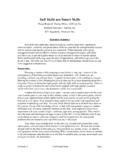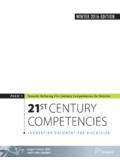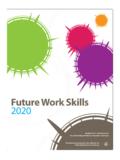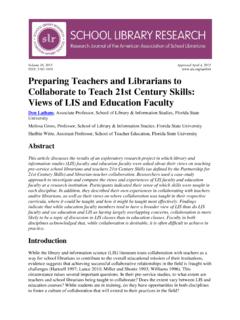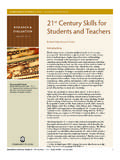Transcription of part one what is 21st century learning? COPYRIGHTED …
1 | part one | what is 21st century learning ? 17/30/09 10:22 AM7/30/09 10:22 AMCOPYRIGHTED 27/30/09 10:22 AM7/30/09 10:22 AM3 learning Past and FutureWe are currently preparing students for jobs that don t yet exist .. using technologies that haven t yet been invented .. in order to solve problems we don t even know are problems yet. Richard Riley, Secretary of Education under ClintonIt happened quietly, without fanfare or 1991, the total money spent on Industrial Age goods in the United States things like engines and machines for agri-culture, mining, construction, manufacturing, transportation, energy production, and so on was exceeded for the fi rst time in history by the amount spent on information and communica-tions technologies: computers, servers, printers, software, phones, networking devices and systems, and the score?
2 In 1991, Knowledge Age expenditures exceeded Industrial Age spending by $5 billion ($112 billion versus $107 billion). That year marked year one of a new age of information, knowledge, and Since then, countries around the globe have increasingly been spending more on making, manipu-lating, managing, and moving bits and bytes of information than on handling the material world s atoms and monumental shift from Industrial Age production to that of the Knowledge Age economy information-driven, glob-ally networked is as world-changing and life-altering as the shift from the Agrarian to the Industrial Age three hundred and fi fty years 37/30/09 12:59 PM7/30/09 12:59 PM4 | 21st century skillsMoving from a primarily nuts-and-bolts factory and manu-facturing economy to one based on data, information, knowledge, and expertise has had a huge impact on the world s economies and our everyday lives.
3 The sequence of steps to produce a prod-uct or service, the so-called value chain of work, has dramatically shifted, as shown in Figure economies are focused on turning natural resources such as iron and crude oil into products we use automobiles and gasoline. Knowledge economies turn information, expertise, and technological innovations into services we need, like medical care and cell phone of course doesn t mean that Industrial Age work will or can go away in the Knowledge Age manufactured products will always be does mean that with increasing automation and the shift-ing of manufacturing (and its environmental impacts) to lower-wage, industrial-equipped countries such as China, India, and Brazil, industrial work in Knowledge Age countries will continue Industrial Age Value ChainExtractionProducts (and Services)ManufacturingAssemblyMarketingD istributionKnowledge Age Value ChainDataServices (and Products)
4 InformationKnowledgeExpertiseMarketingFi gure Value Chains Then and 47/30/09 10:22 AM7/30/09 10:22 AMlearning past and future | 5to decline and service-based knowledge work will continue to grow well into the 21st that s only one of a whole bundle of big changes that have arrived at our doorstep in the early part of the 21st century . And these changes will continue to make new demands on education as the century Thomas Friedman vividly reported in The World Is Flat: A Brief History of the Twenty-First century and in Hot, Flat, and Crowded, the 21st century is challenging and reshuffl ing the very foundations of our society in new, powerful, and often alarming ways. For example: The world now has a truly global fi nancial and economic ecosystem.
5 This highly interlinked system means that a disruption in one part of the world (such as a housing loan crisis) has dire consequences to economies everywhere. The growing disparity in the world between rich and poor leads to social tension, confl icts, extremism, and a less safe world for the biggest challenge to the survival of all societies is the strain we re placing on our physical environment: Global population has risen from billion in 1950 to nearly 7 billion in 2009. This fi gure is expected to exceed 9 billion by 2050. Despite widespread poverty, increasing numbers of people are rising into middle-class lifestyles, which drastically increases their consumption of the earth s material and energy 57/30/09 10:22 AM7/30/09 10:22 AM6 | 21st century skills Increased consumption of resources is causing climate change and other threats to the natural world and its global life-support up overpopulation, overconsumption, increased global competition and interdependence, melting ice caps, fi nancial meltdowns, and wars and other threats to security, and you get quite a bumpy beginning for our new century !
6 But as the Chinese characters for the word crisis (shown in Figure ) suggest, in times such as these, along with danger and despair come great opportunities for change and renewed of education s chief roles is to prepare future workers and citizens to deal with the challenges of their times. Knowledge work the kind of work that most people will need in the coming decades can be done anywhere by anyone who has the expertise, a cell phone, a laptop, and an Internet connection. But to have expert knowledge workers, every country needs an education sys-tem that produces them; therefore, education becomes the key to economic survival in the 21st further understand what our times demand of education we must take a closer look at the changing world of 21st century work.
7 Wei ji (danger) (opportunity)Figure Signs for Our 67/30/09 10:22 AM7/30/09 10:22 AMlearning past and future | 7 learning a Living: The Future of Work and CareersA few years ago, four hundred hiring executives of major corpo-rations were asked a very simple but signifi cant question: Are students graduating from school really ready to work? The exec-utives collective answer? Not study clearly showed that students graduating from sec-ondary schools, technical colleges, and universities are sorely lack-ing in some basic skills and a large number of applied skills : Oral and written communications Critical thinking and problem solving Professionalism and work ethic Teamwork and collaboration Working in diverse teams Applying technology Leadership and project managementReports from around the world confi rm that this 21st century skills gap is costing business a great deal of money.
8 Some estimate that well over $200 billion a year is spent worldwide in fi nding and hiring scarce, highly skilled talent, and in bringing new employees up to required skill levels through costly training programs. And as budgets tighten further in tough economic times, companies need highly competent employees ready to hit the ground run-ning without extra training and development competitiveness and wealth of corporations and countries is completely dependent on having a well-educated workforce as 77/30/09 10:22 AM7/30/09 10:22 AM8 | 21st century skillsone 2006 report called it, learning Is Earning. Improving a country s literacy rate by a small amount can have huge positive economic impacts.
9 Education also increases the earning potential of workers an additional year of schooling can improve a per-son s lifetime wages by 10 percent or why is education falling short in preparing students for 21st century work?The world of Knowledge Age work requires a new mix of skills . Jobs that require routine manual and thinking skills are giving way to jobs that involve higher levels of knowledge and applied skills like expert thinking and complex communicating (see Figure ).Today s Jobs Require New Skills1969complex communication198019901998151050 5 10 Percentage Changeroutine manualexpert thinkingroutine cognitiveFigure New skills for 21st century : Adapted from Levy and Murnane, 87/30/09 10:22 AM7/30/09 10:22 AMlearning past and future | 9 Table lists examples of jobs requiring routine and manual skills and those with high demands for complex communicating and thinking rising demand for a highly skilled workforce also means that there will be a growing income gap between less educated, relatively unskilled workers and highly educated, highly skilled workers.
10 Routine tasks are increasingly being automated, and the routine jobs still done by people barely paid a living wage. Routine work is moving to countries where the cost of labor is very low, as shown in Figure world s education systems must now prepare as many stu-dents as possible for jobs at the top of the chart the high-paying Table Jobs and 21st century of Task Task Description Example OccupationsRoutine Rules-based Bookkeepers Repetitive Assembly line workers Procedural Manual Environmental adaptability Truck drivers Interpersonal adaptability Security guards Waiters Maids and janitorsComplex


